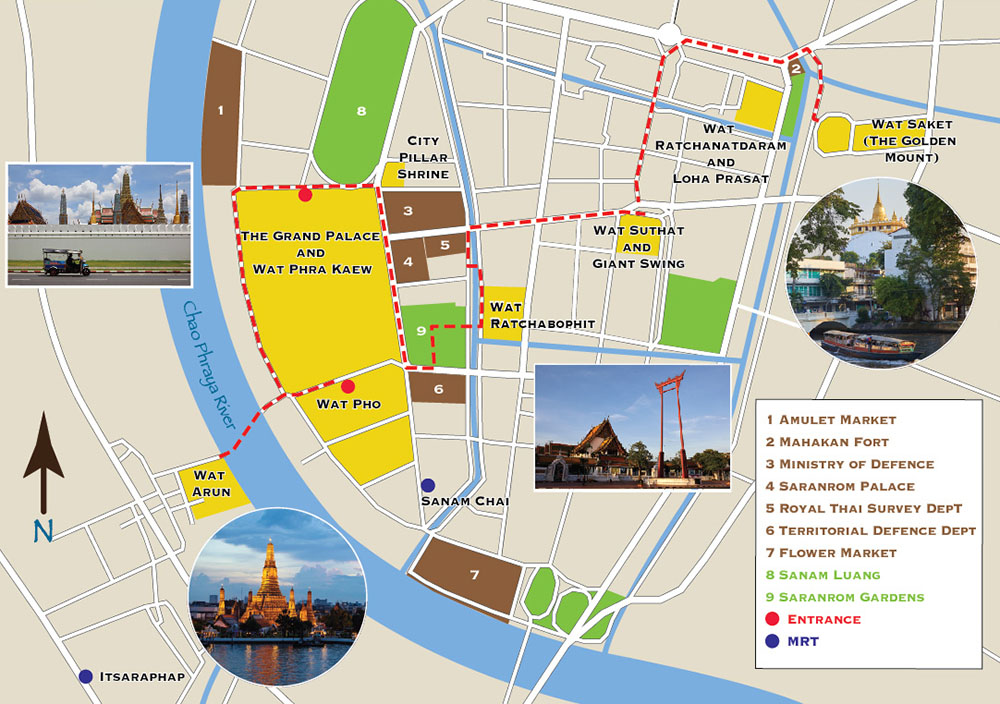Bangkok on foot – Temples, palaces and parks
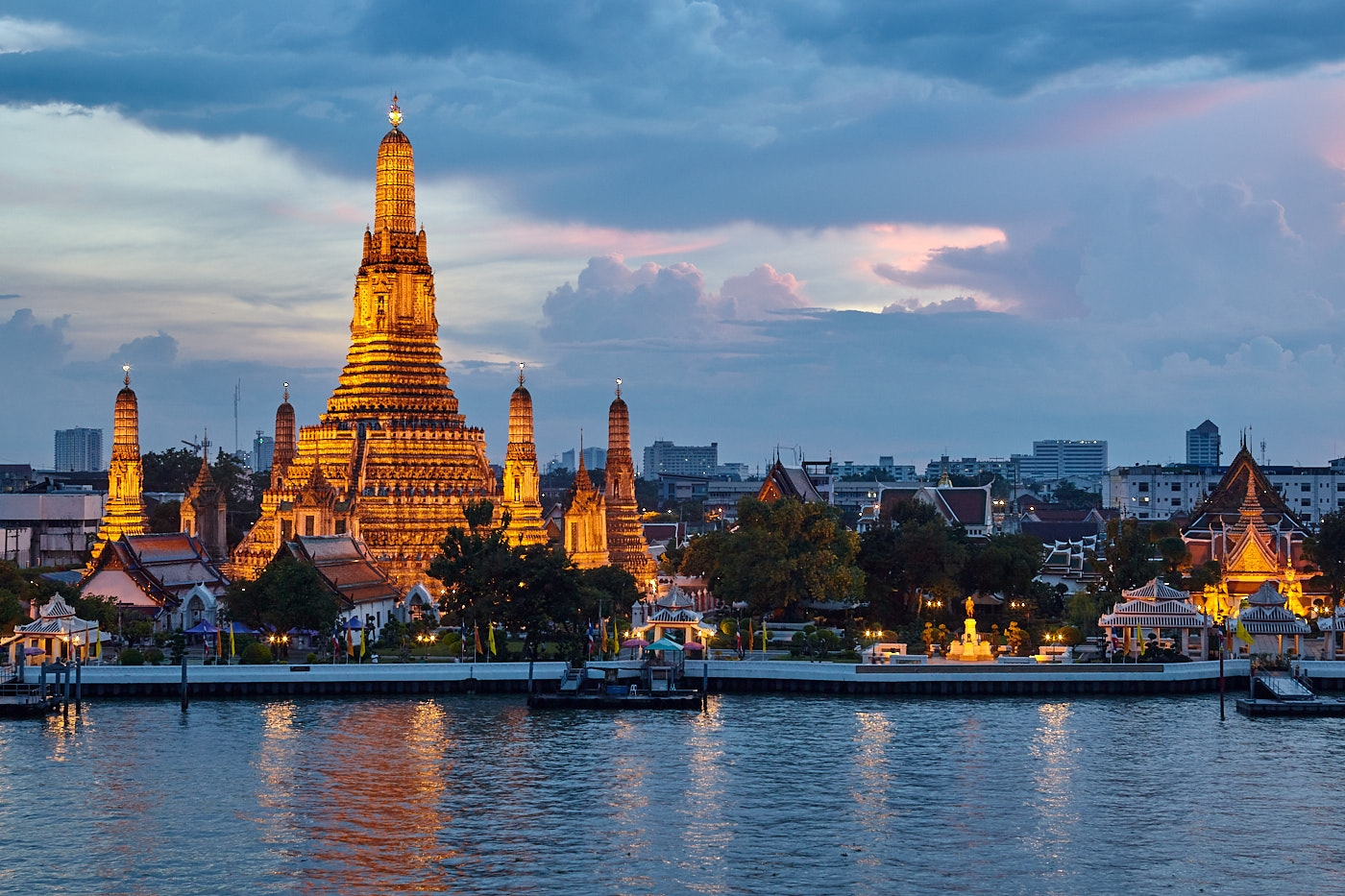
Bangkok on foot – Temples, palaces and parks
You could spend weeks in Bangkok and still not see all there is to see. Most visitors, of course, don’t have weeks to spare. But it is possible to see most of the important historical sights in a day and you can do it at your own pace and see lots of cool things in between.
Here I describe a route that I have walked many times and give brief explanations of what you’ll see along the way. If you want more detailed descriptions of these locations, and everywhere else in the city for that matter, then I recommend the book 22 Walks in Bangkok by Ken Barrett.
You could even start in the middle and only do part of it if you want. But I always like to start the day at The Temple of Dawn, which is about ten minutes walk from Itsaraphap MRT station. It opens at 08.00 am but if you are a little early there’s plenty to see while you wait.
Wat Arun, the Temple of Dawn
The central Khmer style prang, surrounded by four smaller prangs (main picture) is one of the most recognisable symbols of Bangkok. Together they represent Mt. Meru, the five-peaked mountain at the centre of Buddhist and Hindu cosmology. But it hasn’t always looked like this. There had been a temple here as far back as the mid-seventeenth century. In those days it was called Wat Makok, named for the plum-like fruits that grew in the area. It didn’t become historically significant until the late eighteenth century when General Taksin, marshalling his troops on the way to liberating Ayutthaya passed by just as dawn was breaking.
Ayutthaya, the former capital of Siam, had been sacked and occupied by the Burmese army in 1763. Taksin’s mission was to boot them out again. He returned successful, was crowned king in 1767 and set about building his new capital here. He had the temple incorporated into his palace grounds and he renamed it Wat Chaeng, meaning The Temple of Dawn.
For a brief period from 1779 the Emerald Buddha, the most sacred Buddha image in all of Thailand was enshrined here, lending the temple a mystique that lingers to this day. Taksin’s reign lasted only until 1782 when the current Chakri Dynasty was founded. His successor, Rama 1 moved the capital across the river.
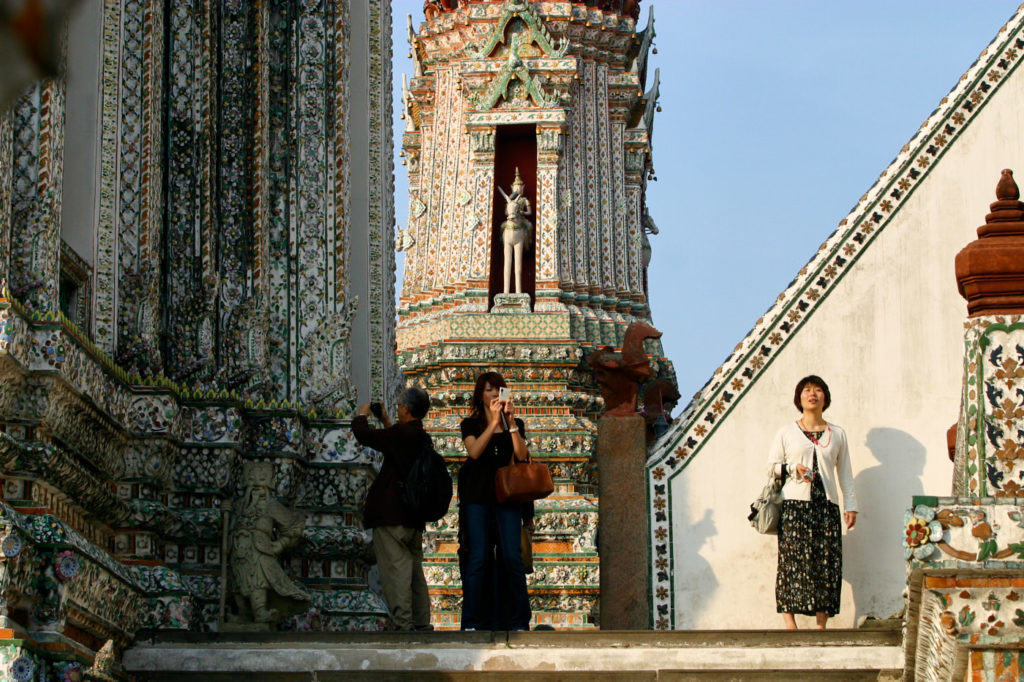

The steps on the prang at Wat Arun can be quite steep (left). Two demons guard the ubosot.
The temple fell into disuse for several years but was restored by Rama 2 who raised the prang to its present height of 67 metres and renamed it Wat Arun Ratchawararam Ratchawaramahawihan after Aruna, the Hindu god of dawn. To the north of the prang, guarded by two demons, is the ubosot or ordination hall. On the front of the hall is the Niramitr Buddha image, believed to have been designed by Rama 2 and beneath which his ashes are interred.
Also worth looking into is the old ubosot. Located directly in front of the prang, this is where King Taksin spent his final weeks meditating prior to his execution. According to historians the king had become mentally unstable after years of warfare and was deposed in a coup. His bed, a simple teak platform can be seen just inside the door.
There is a ferry pier, just to the north of the temple, where you can cross the river to Wat Pho. Disembarkation is at an old wooden pier called Tha Rong Mo. The pier itself is filled with souvenir shops but as you exit you will see a lovely row of old shop houses on the right. They were built during the reign of King Chulalongkorn, Rama V. The exterior has been renovated and the building is now home to a number of coffee shops and bistros. Behind the facade, there is a wet market that is famous for its salted fish and seafood products and where life goes on much as it has done for decades.
Follow the road leading from the pier and across the intersection at Maharat Road. You will see the white crenellated wall and neatly clipped lawn that encloses the Grand Palace on the left and the rooftops of Wat Pho on your right. The entrance to the temple is about 150 metres from the ferry pier.
Wat Pho
The name is a contraction of the temple’s former name, Wat Phodaharam. No one is sure of when it was founded but scholars believe there was a temple here at least as far back as 1688 making it one of the oldest temples in Bangkok.
In 1788 Rama 1 ordered the old temple to be renovated. Abandoned and damaged Buddha images were brought back from Ayutthaya, Sukhothai and other ancient sites from around the country to be kept here. One of these was a huge reclining Buddha from Ayutthaya which was incorporated into a chedi. The renovations took seven years to complete and 1801, he bestowed upon it the current formal name of Wat Phra Chetuphon Wimon Mangkhalaram. But most people still call it Wat Pho.
The temple grounds cover a whopping 80,000 square metres although this is divided into two sections with Chetuphon Road passing through the middle. The compound south of the road includes the school and monastery buildings. The main temple buildings lie on the northern side.
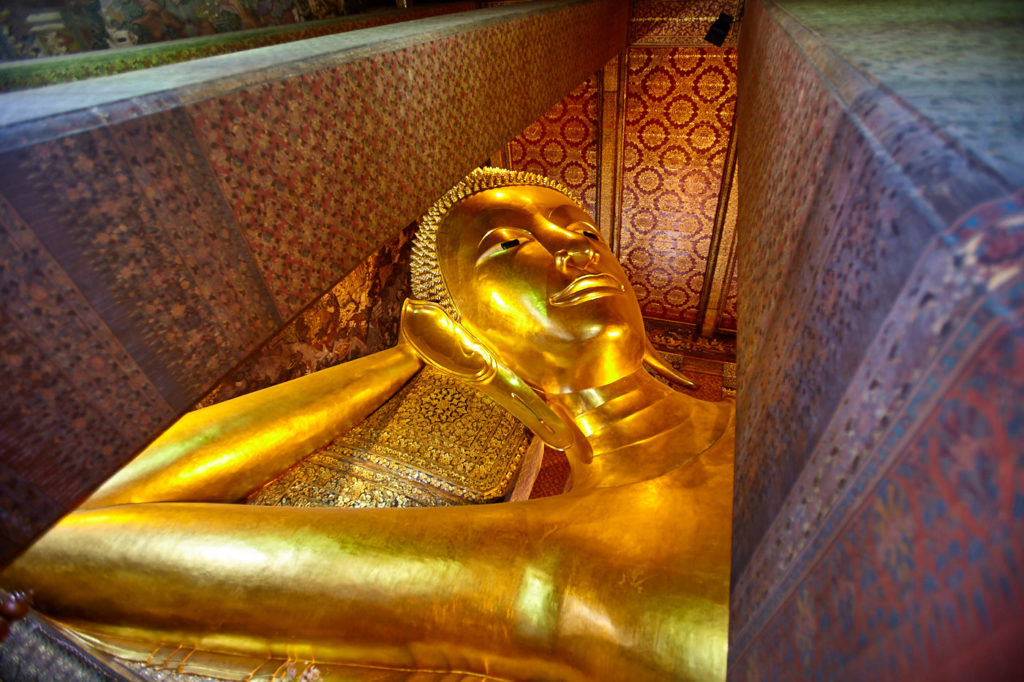
The reclining Buddha (top). Some of the ninety-one chedis (bottom left) and monks joining the early morning prayer session.
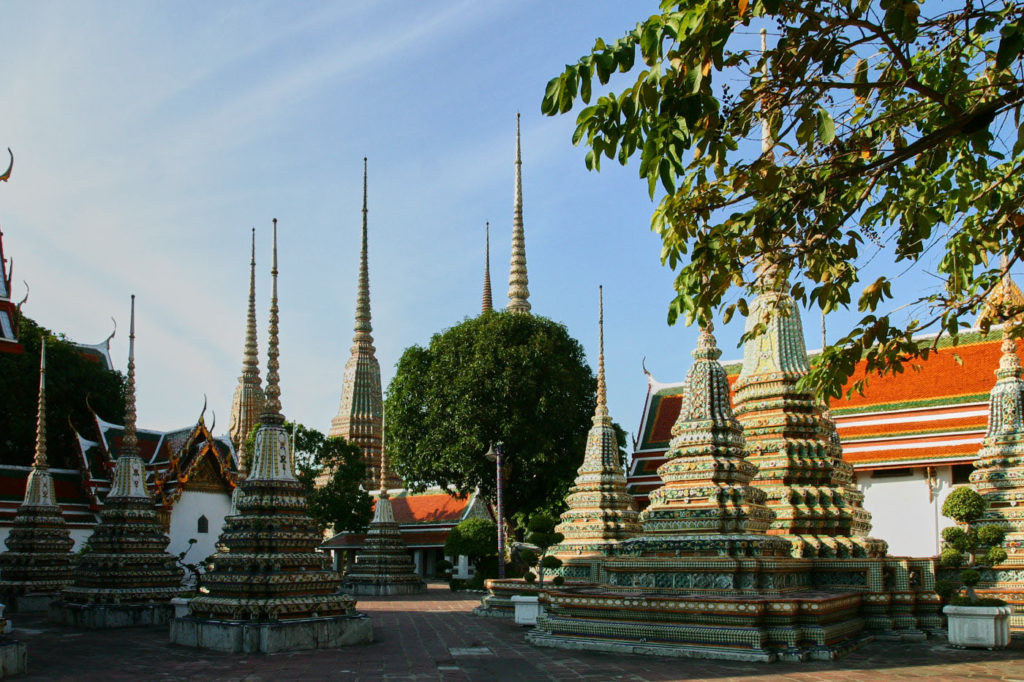
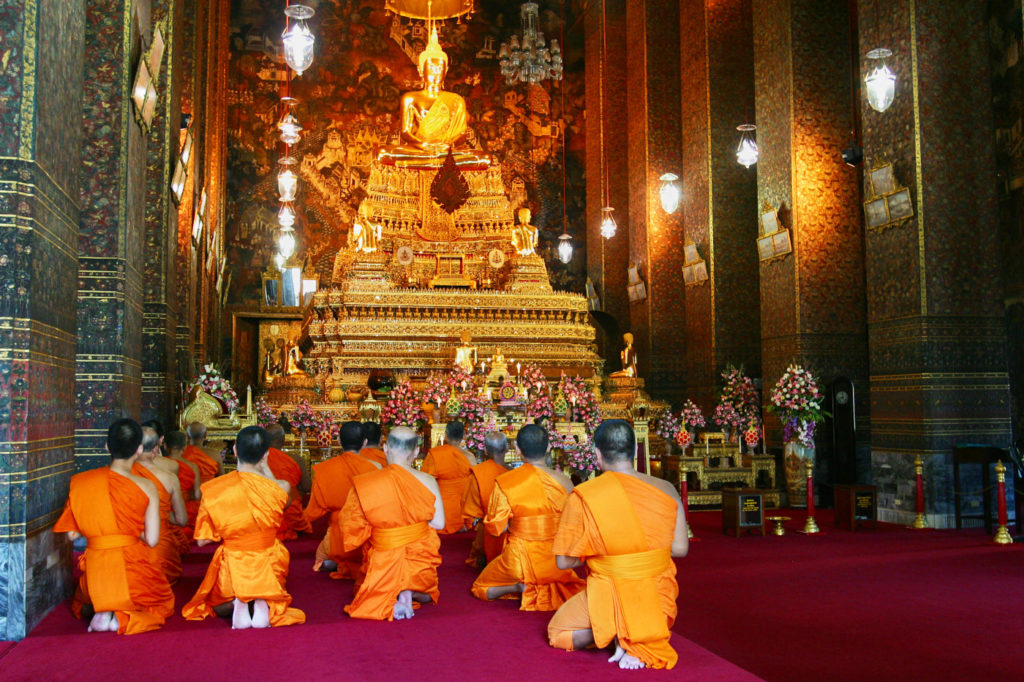
In 1832, Rama 3 ordered another extensive renovation. This included the construction of a new wiharn to contain a huge new reclining Buddha. The figure measures 15.4 m high and 45.7 m long and the feet and eyes are inlaid with mother of pearl. Along the back of the figure are 108 bronze bowls representing the 108 auspicious characters of Buddha. Dropping coins into them is believed to bring good luck. It also helps pay for the upkeep of the temple.
Elsewhere in the compound, you will find the Phra Rabiang which contains about 400 of the Buddha images collected from around Thailand during the reign of Rama 1. They come from all eras of Siamese history but were all renovated with stucco and gold leaf. The compound also boasts ninety-one chedis, the smaller ones containing the ashes of royal family members. The larger ones, clustered in four groups of five contain relics of the Buddha.
The temple was also the first public university in Thailand teaching religion, science, and literature. In 1955 a school for traditional medicine was established and now offers courses in traditional Thai massage. The technique taught at Wat Pho has been included in Unesco’s list of Intangible Cultural Heritage.
Related: Sukhothai, the cradle of Thai civilisation
Related: Historic towns of the Sukhothai Kingdom
After leaving Wat Pho turn left and retrace your steps following the Palace walls and turn right into Maharat Road. It’s quite a long hike around to the entrance to the Grand Palace. Most of the land on the left between the road and the river is owned by the Royal Thai Navy but along the way, you will see the Ratchaworadit Royal Pier and Rajakij Winitchai Pavilion. These were built during the reign of King Mongkut, Rama IV and are only used for ceremonial occasions.
At the next intersection, there is a row of shophouses, painted yellow and white with ornate pediments, pillars and blue wooden shutters on the windows. The area here is known as Tha Chang Wang Luang or “Elephant Pier of the Grand Palace” as it was here that the royal elephants were brought to bathe each morning. The shophouses were built in the late nineteenth century and are some of the most charming in the city.
For the entrance to the Grand Palace, turn right into Na Phra Lan Road. There is another row of shop houses on the left. The Palace is the single most popular attraction in Bangkok and crowd control measures are often in place. The entrance is opposite the end of the row of shophouses.
Wat Phra Kaew and the Grand Palace
After Rama 1 ascended the throne in 1782 he decided to move the capital across the river from Thon Buri. He chose a site between two old temples, Wat Pho and Wat Mahathat. The first palace was a temporary affair built of wood but it enabled him to symbolically cross the river and enter for a hasty coronation. A more substantial residence was constructed from the bricks of the old royal palace in Ayutthaya. He imported five thousand labourers from Laos as well as craftsmen and artists from Thon Buri, most of whom had originally come from Ayutthaya. When the ceremonial pavilions were completed, in 1785, there was a more elaborate coronation.

The spires of Wat Phra Kaew seen from across Sanam Luang (top). A demon guard at Wat Phra Kaew (left); and within the grounds

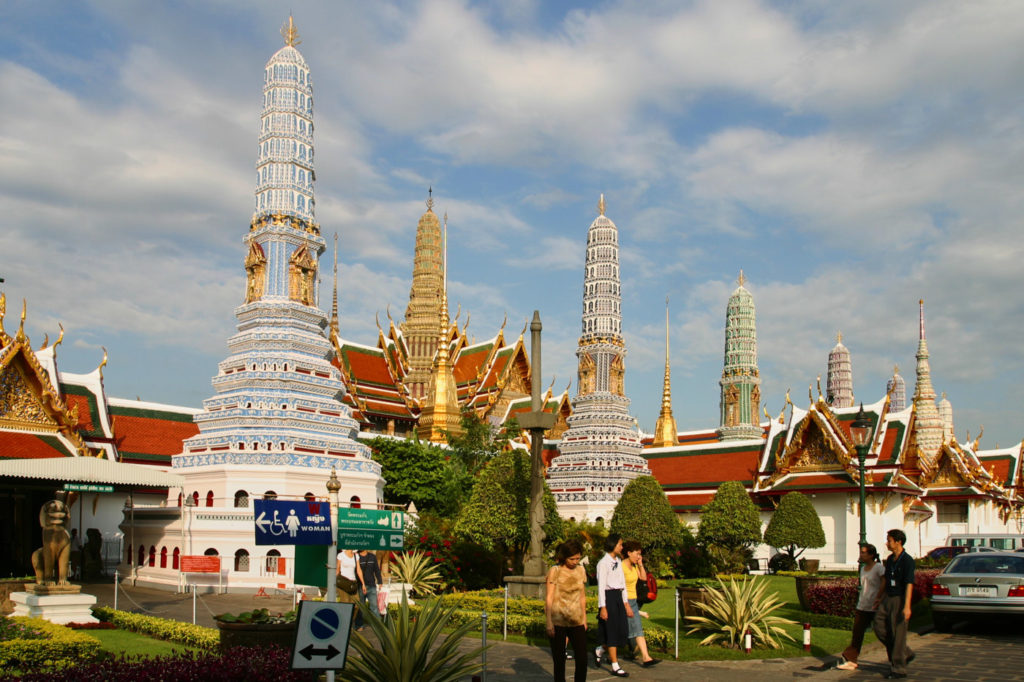
Within the compound, he also built Wat Phra Kaew to house the Emerald Buddha, which he had captured from Vientiane in 1778. The Emerald Buddha is the single most important Buddha image in the country. At just 66 cm tall it shows the Buddha seated in the lotus position and clothed in gold. But while its proportions seem a bit small for such an important image, its story is a long one.
According to legend, it was crafted in India around 43BCE, and its job was to help spread Buddhism to other countries. It was sent first to Sri Lanka and then on to Bagan in present-day Myanmar but it mysteriously disappeared en route to the latter. It was then said to have resided at Angkor, Ayutthaya, Kamphaeng Phet, Chaing Rai, Chiang Mai, Luang Prabang and Vientiane, although records only start in 1391 when it was taken from Kamphaeng Phet to Chiang Rai.
The Emerald Buddha is said to bring peace to the country in which it resides and legitimacy to its rulers. It is believed to be carved from a single block of jade or jasper but since the king, who changes its robes three times a year, is the only person allowed to touch it, no one has ever been able to test it.
The Palace itself is a huge complex of pavilions and halls featuring traditional Thai as well as European architectural styles. It was the official residence of the king, his court and government until 1925 when the royal residence moved to Dusit Palace. The Grand Palace is still used for ceremonial and state functions. There are also a number of interesting museums in the compound including the Queen Sirikit Museum of Textiles and the Pavilion of Regalia, Royal Decorations and Coins.
Stately Buildings and Quaint Bridges
After leaving the Palace turn right and follow Na Phra Lan Road to the end where it meets Sanam Chai Road. A white prang marks the city pillar shrine or Phra Lak Muang. The shrine was inaugurated on April 21, 1782, before construction of the new city began. It has been renovated numerous times over the years. There are actually two pillars within the shrine. When Rama IV ascended the throne he renovated it and replaced the pillar with the smaller one. When it was renovated again in 1980 the original was reinstated alongside.
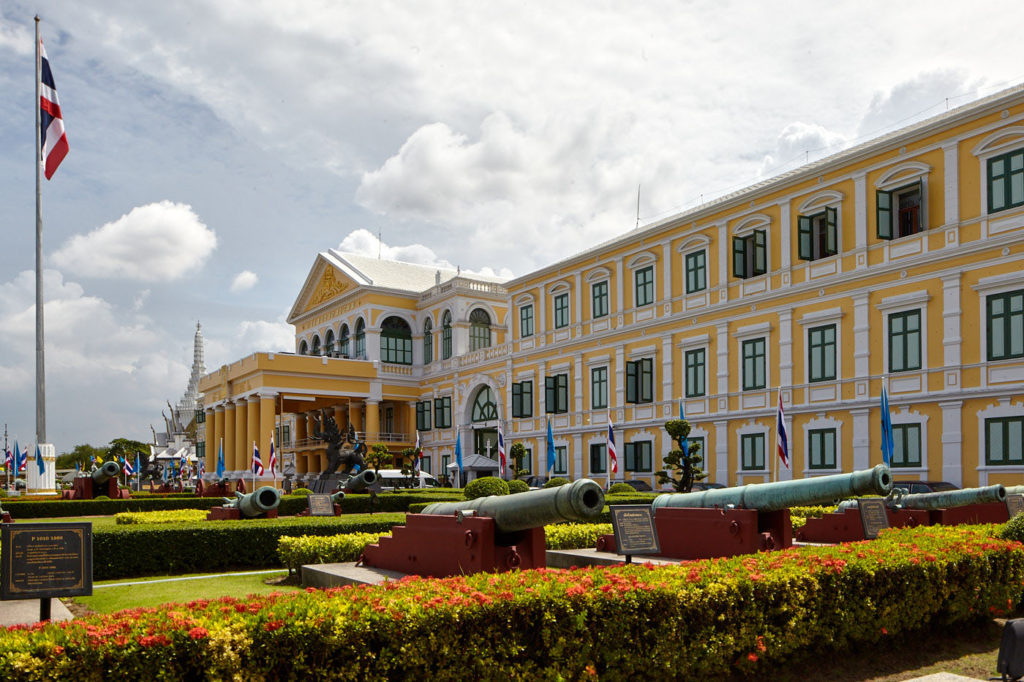
The Ministry of Defence building
To the right of the shrine is the majestic Ministry of Defence building. It was designed by Joachim Grassi in Neo-Palladian style. Grassi was one of a number of Italian architects who had been employed by Rama V to help modernise the city. Their influence can be seen all over the city from the major public buildings to decorative pediments on shop houses, the main railway station and even the ornamentation of lamp posts.
The building was completed in 1884 as a barracks for front soldiers. When the Ministry of Defence was established in 1887 it became the headquarters. The front lawns bristle with a display of vintage canon. The largest and most famous is the Phaya Tani. This was cast in the seventeenth century on orders from the Sultanate of Pattani after rumours circulated of a forthcoming attack from Siam. After the fall of Ayutthaya in 1767 the Sultanate declared independence but in 1785 the Thai army invaded and the southern province has been a part of Thailand ever since.
The red-ochre building a little further along Sanam Chai Road and partly hidden by trees is Saranrom Palace. Rama IV had commissioned this building in 1866 as a place to retire but the king died in 1868 before completion. The building, which had been designed by British diplomat Henry Alabaster, was then used as a temporary residence for various members of the royal family as well as accommodation for visiting dignitaries.
Rama VII handed the palace to the Ministry of Foreign Affairs who used it as their headquarters until 1992. It was here that, on August 8, 1967, Thailand, Malaysia, Singapore, Indonesia and the Philippines signed a declaration founding the Association of South East Asian Nations (ASEAN).
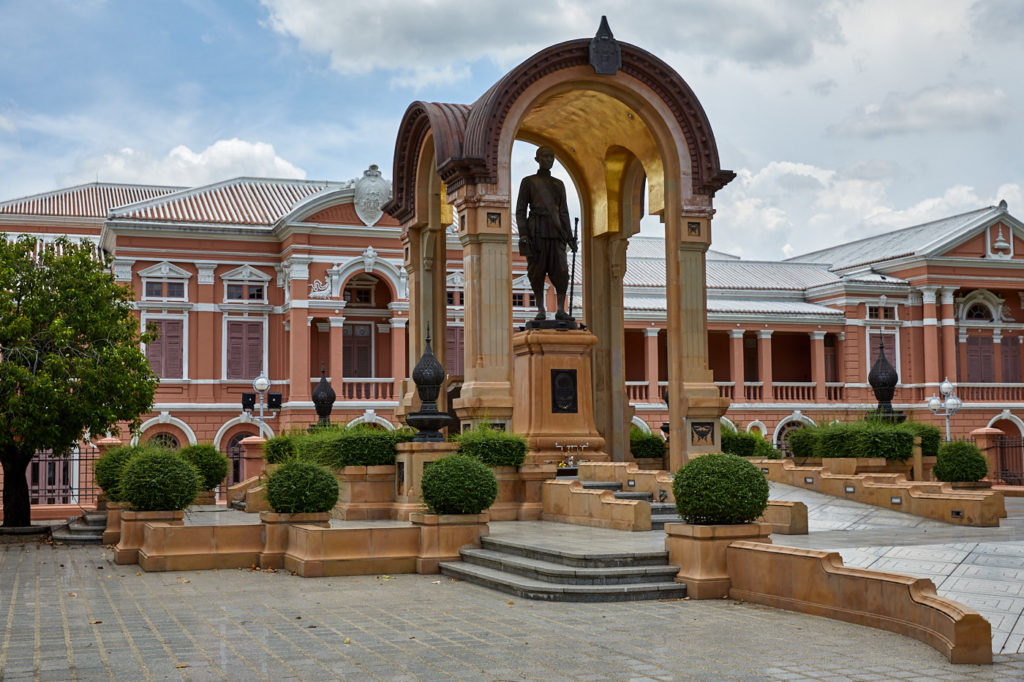
Saranrom Palace with a statue of King Mongkut, Rama IV in front (top). The Ratchawonlop Building, home to the Territorial Defence Command and the Rama VI museum (below left) and the leafy Saranrom Park.
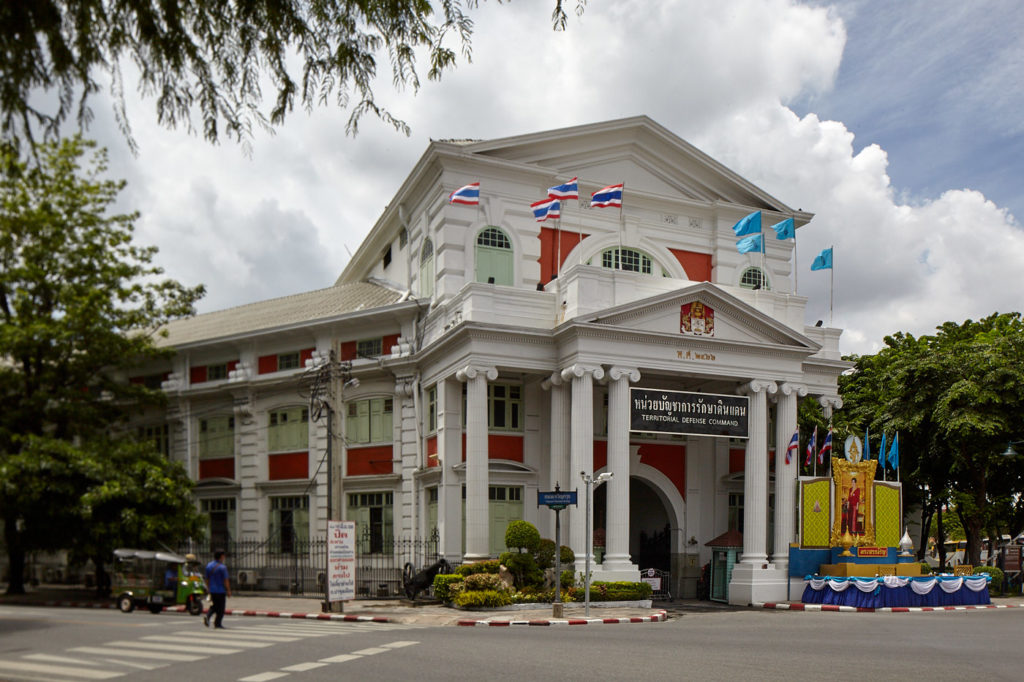
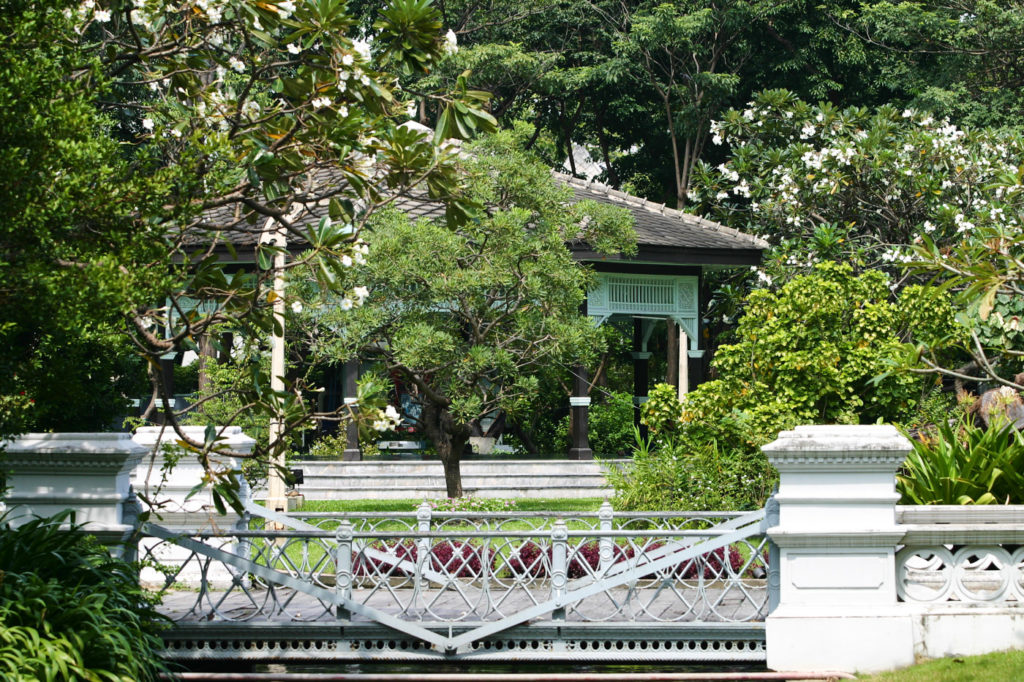
Further along, past the Privy Council Chambers, is Saranrom Park. Formerly the grounds of the Saranrom Palace they were turned into a public park in 1960. The entrance is around the corner on Charoen Krung Road. On the way, you will also be able to enjoy the stately Romanesque columns of the Ratchawonlop Building. Opened in 1922 the building houses the Territorial Defence Command and the Rama VI museum. The collection includes exhibits from the king’s military service including uniforms and other personal effects.
Charoen Krung Road is the oldest road in the city. Construction began in 1862 and the road ran from this point for about 8.5 kilometres serving Chinatown, the old European community at Bang Rak and ending at a small pier at Bang Kho Laem. The construction of the road heralded the change from water to land as the major mode of transport in the city.
Entrance to Saranrom Park is through a large wrought iron gate about a hundred metres along. The garden is an oasis of peace. Laid out in European style with a brass band pavilion, ornamental fountains, lakes, lily ponds and a small pagoda which is a shrine dedicated to Chao Mae Ta-khian Thong, a spirit of the trees. The trees are also inhabited by rowdy crows and the occasional squirrel. If you are lucky you might catch sight of a monitor lizard sunning itself on the side of one of the ponds.
There is a side exit from the park which brings you out onto Rachini Road, which runs alongside Klong Khu Muang Doem, the inner moat. Directly opposite you will see Saphan Hok, a Dutch-style cantilever footbridge. Originally six had been built during the reigns of Rama IV and V. All of the originals have since disappeared, this one was rebuilt in 1982. Cross the bridge and turn left onto Asadang Road towards Wat Ratchabophit.
Wat Ratchabophit
This was the first temple built by Rama V after he ascended the throne. It was completed in 1869 and demonstrates the unique blend of European and Thai styles that the king was fond of. Facing the road is a royal graveyard that boasts a mixture of chedis, Khmer-style prangs and Gothic spires. The doors into the temple are decorated with Western-style guards.
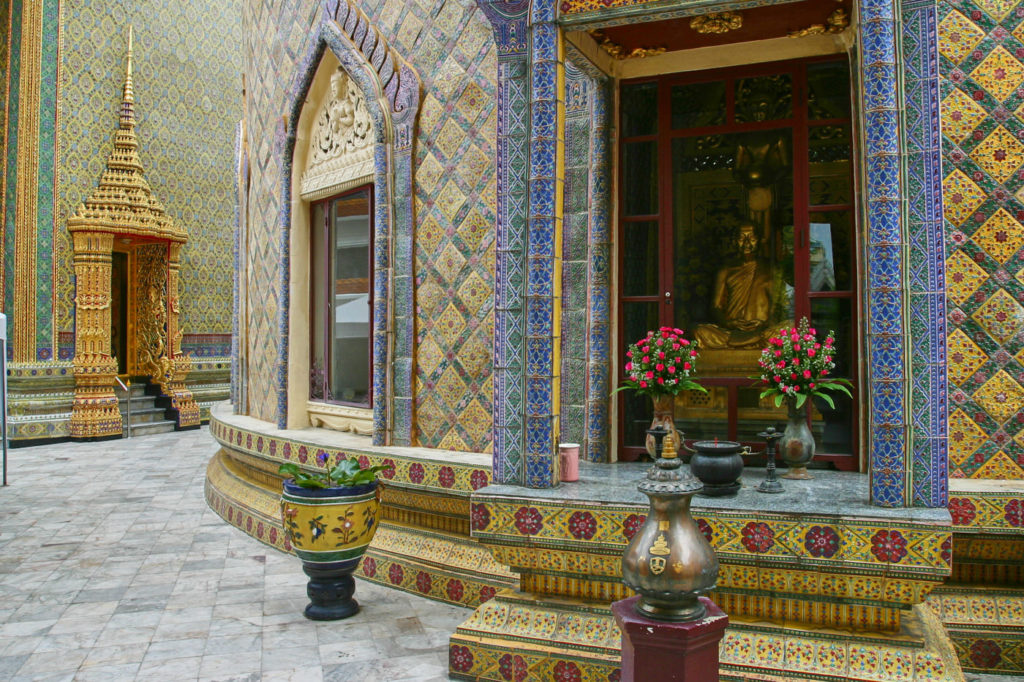
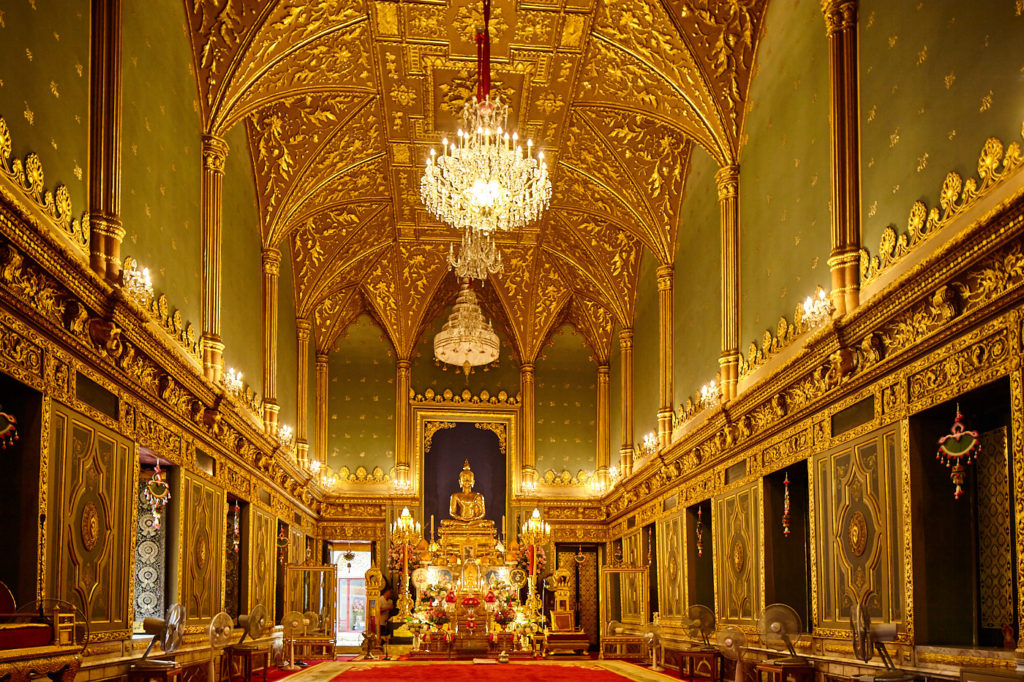
The circular cloister (left) and the gothic-inspired ubosot at Wat Ratchabophit
Once inside a circular cloister connects the wiharn and ubosot whilst in the middle stands a large gilded 43-metre-high chedi. The interior of the ubosot is decorated in a beautifully detailed Gothic revival style.
To the right, after leaving the temple, you will see the Pi Kun footbridge across the canal. It was built in 1911 to commemorate Queen Sripacharintra’s 48th birthday. The Queen was born in the year of the pig according to Chinese astrology. The four pillars are said to represent candles, one for each twelve-year cycle. The Pig Memorial next to it, on the Rachini Road side, was built for her 50th birthday with donations from friends.
A little further along on the corner facing the rear of the Ministry of Defence is the Royal Thai Survey Department. Built in 1892 for the military academy it was taken over by the survey department in 1931. The building also houses a map-making museum.
The bridge here is called Chang Rongsee Bridge. It is a simple concrete structure built in 1910, the year of the dog. A detail that is commemorated by a sculpture of a dog’s head at each of the corners. Cross over the bridge and continue along Bamrung Mueang Road.
The district to the left is known to locals as Sam Phraeng or three roads. The roads in question are Phraeng Phuton, Phraeng Nara and Phraeng Sanphasat. This was once one of the most fashionable areas of Bangkok. When King Chulalongkorn ascended the throne his three brothers built palaces here but over the years the area fell into decline.
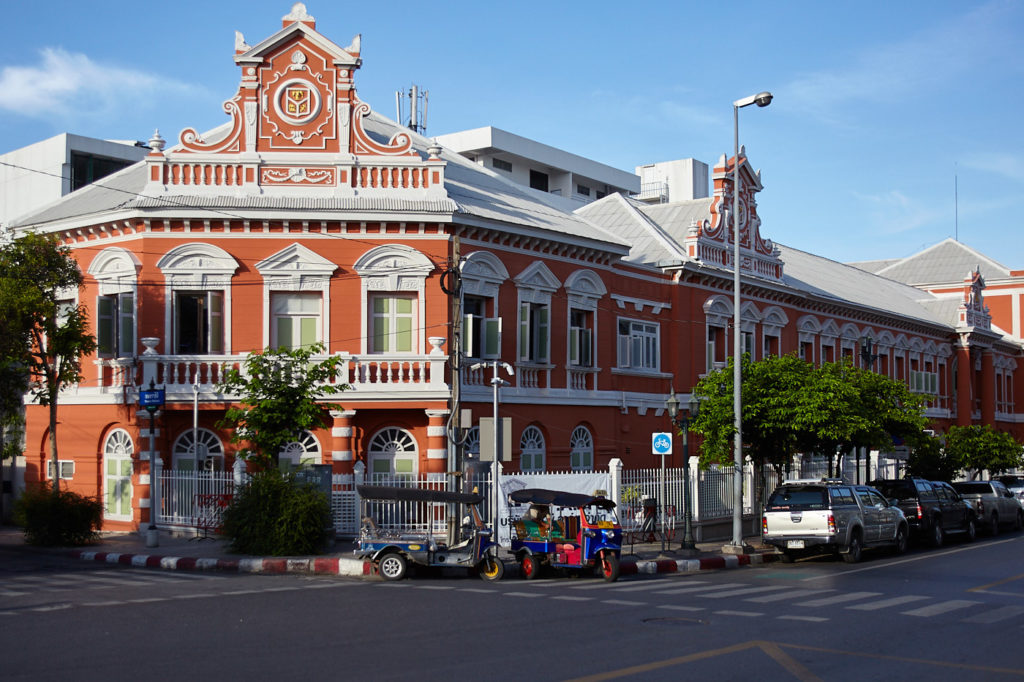
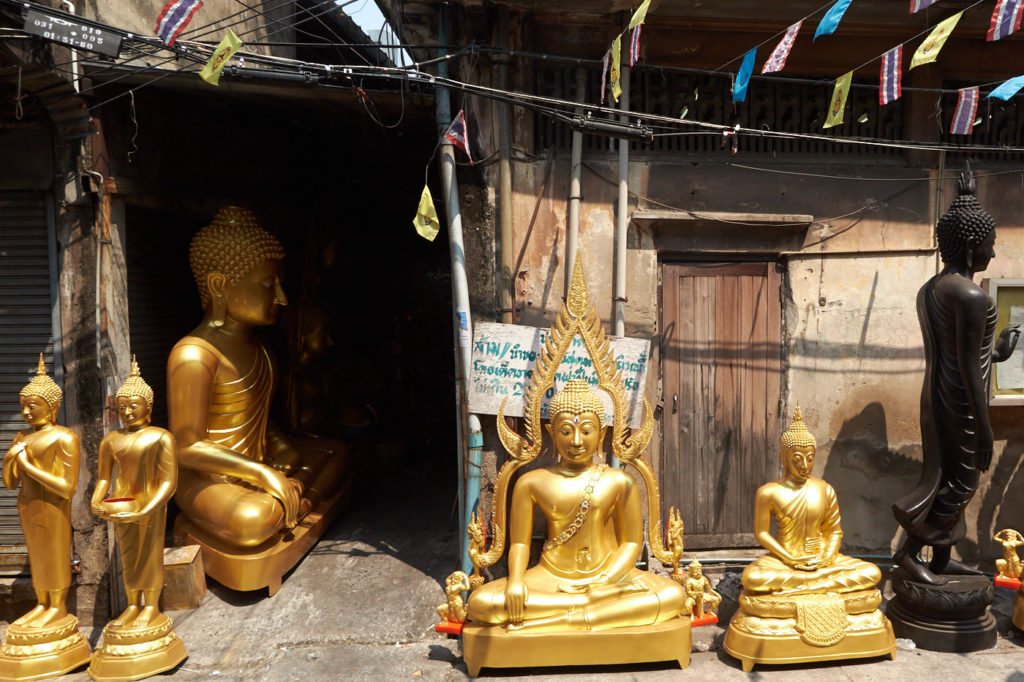
Royal Thai Survey Department (left). Hand-crafted Buddha images on a backstreet off Bamrung Mueang Road.
It hit rock bottom after the 1932 revolution when Phreang Phuton became a notorious red-light district. The turning point came in the 1980s when the local residents got together to save the area. With the help of the Fine Arts Department and the Bangkok Metropolitan Administration (BMA), they invested their own time, effort and skills to restore the little shophouses. The walls were painted a uniform cream with green trim and today the short alley from Bamrung Mueang Road to Phraeng Phuton reveals a delightful square with a small garden and shops, restaurants, a clinic and a workshop restoring vintage cars.
Bamrung Mueang Road, built a year after Charoen Krung Road, is the second oldest road in Bangkok. After the intersection with Tanao Road, it becomes fairly narrow with little traffic. Most of the shops along here sell religious supplies, everything you might need for temples and shrines large or small. If you slip into one of the backstreets around here, the road is actually called Soi Thesa but it is not marked, you will find numerous workshops where Buddha images are made. The reason that so many religious shops are clustered together is because of the proximity of Wat Suthat.
Wat Suthat and the Giant Swing
Rama 1 commissioned the building of Wat Suthat in 1807 but it wasn’t completed until the reign of Rama III in 1847. It is a grade one royal temple responsible for training and supplying priests to temples throughout Thailand. The grounds of the temple are enormous and include the city’s longest ordination hall at seventy-two metres. The main Buddha image was rescued from Sukhothai.
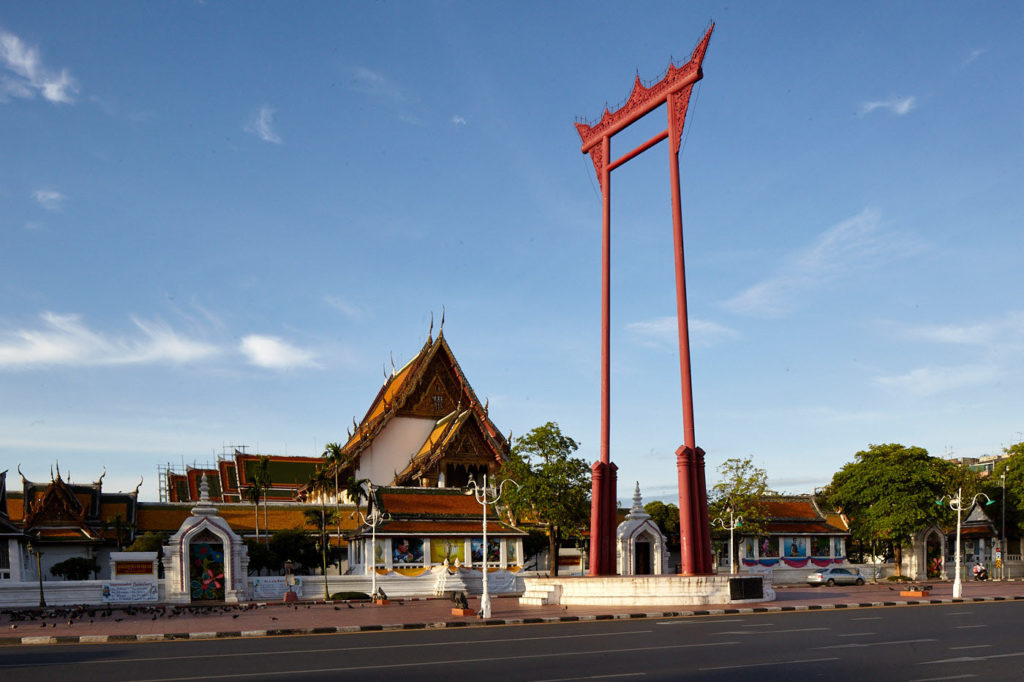
Wat Suthat and the Giant Swing
Cast in bronze in 1361, it had languished amidst the ruins for four hundred years. Rama 1 ordered it to be floated down the river for installation in a specially built ubosot but at eight metres tall it was too big to fit through the gate at the pier. A section of the city wall had to be cut away and the king himself helped haul the image to its destination and hoist it into position.
The wiharn is decorated with murals painted during the Rama III era using Western techniques of perspective that were only just being understood by Thai artists. Surrounding the wiharn are twenty-eight Chinese pagodas symbolising the twenty-eight Buddhas born on earth.
The Giant Swing is 21 metres (69ft) high and stands on an elongated traffic island between Wat Suthat and the Lan Khon Mueang Town Square. It has been visible from the moment we turned into Bamrung Mueang Road but it is only at close quarters that one appreciates just how big it is. It was built in 1784 outside the nearby Devasathan shrine and was originally used for Brahmin ceremonies.
The ceremonies were discontinued in the early nineteenth century after the swing was hit by lightning. It was moved to its current location in 1920 and in 1935 the ceremony was held one last time. It involves young Brahmins riding the swing attempting to catch bags of gold coins, suspended from poles, with their teeth. During the ceremony, several of the participants fell to their death so it has never been performed since. The swing was rebuilt in 1959 and again in 2007.
At the far side of the Lan Khon Mueang Town Square is the BMA City Hall. Din So Road runs along the left side of both. The road continues in a straight line until it meets Ratchadamnoen Avenue. The name means Royal Way and the road, a broad tree-lined avenue, was built to connect the Grand Palace with Dusit Palace which had been built in 1901 as a new, more spacious residence for the royal family.
Loha Prasat
Din So Road meets the avenue at the Democracy Monument, which was built in 1939 to commemorate the adoption of democracy and the transition to a constitutional monarchy. The monument forms a large traffic island. Turn right here and after about 300 metres or so you will pass Wat Ratchanatdaram and the Loha Prasat.
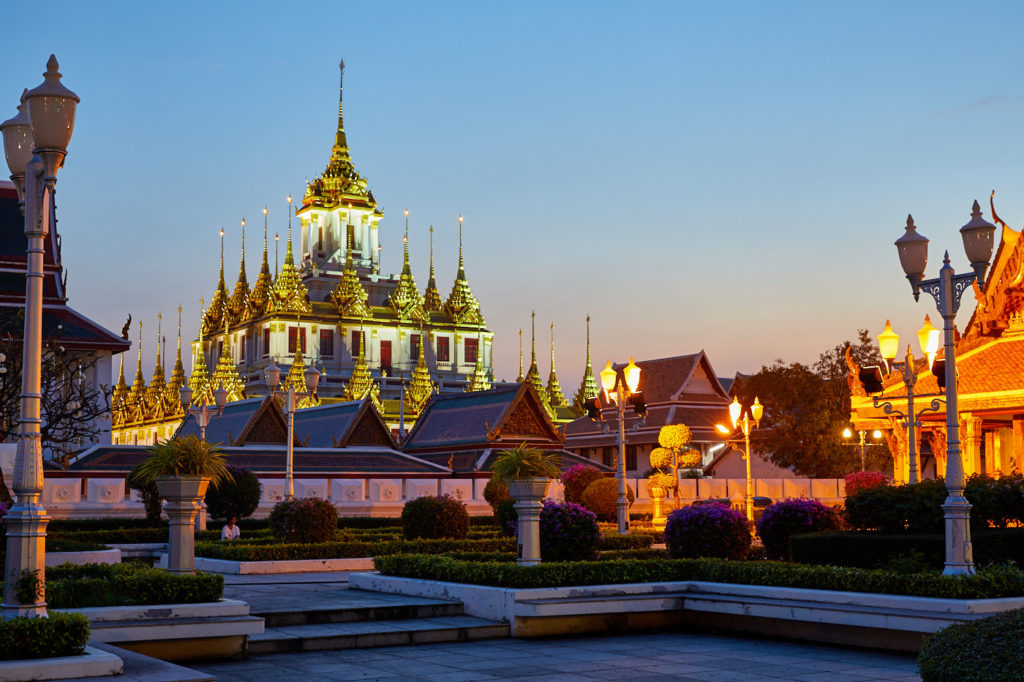
The golden spires of the Loha Prasat (top). The Phan Fa Lilat Bridge (left) and a single cannon defends the realm at Mahakan Fort.
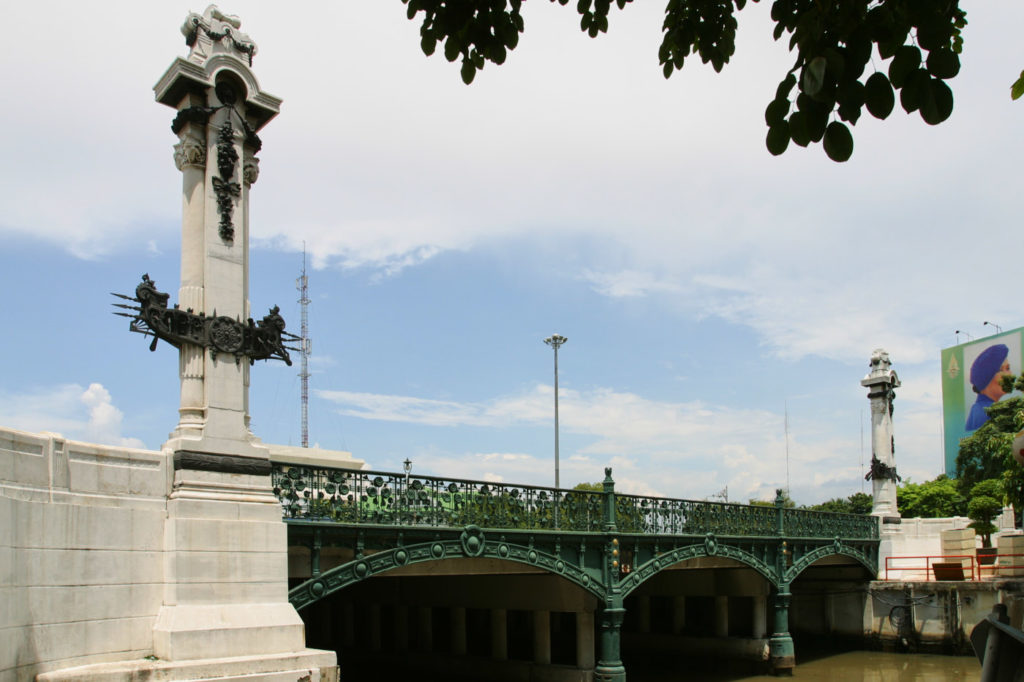
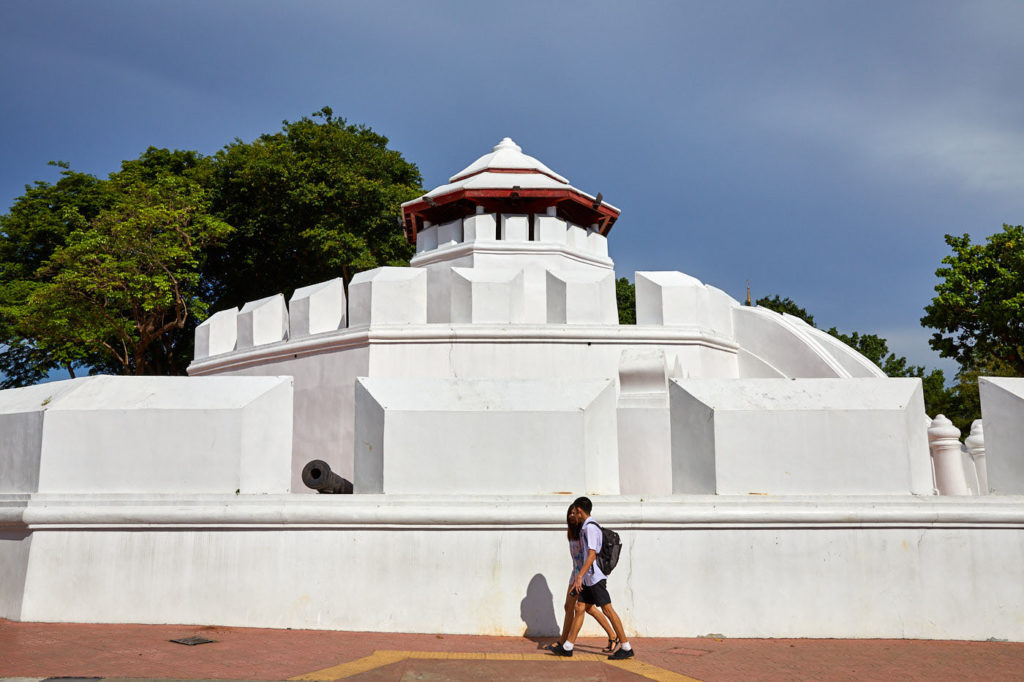
With a foreground of two pavilions and an ornamental garden often filled with colourful flowers the Loha Prasat is a striking sight. The words mean iron castle, it consists of five tiers and is 36 metres high. The first, third and fifth tiers sport thirty-seven spires; twenty-four, twelve and one respectively. These represent the thirty-seven articles that must be attained to achieve enlightenment. It was built in 1846 based on the design of Anuradhapura in Sri Lanka but this is the only one in existence today.
Just across Maha Chai Road stands the Mahakan Fort. There used to be fourteen of these forts dotted along the old city wall but only two remain (the other is Phra Sumen on Phra Athit Road). It was built in the late eighteenth century to protect the new city from attack. The Burmese did try in 1785 but their armies never reached Bangkok so the fortifications were never tested. The fort is set in its own park which was completed in 2019.
Spanning the Bang Lamphu canal is Saphan Phan Fa Lilat. The name translates as Bridge of Who Passes The Sky. It is a handsome wrought iron bridge with beautifully carved marble columns at either end. The columns are further decorated with bronze ornamentation.
Immediately around the corner to the right is the Mahadthai Uthit Bridge or Bridge of Tears. This was built after the passing of Rama V and features lifelike images by Italian sculptor Vittorio Novi of citizens crying for the loss of their king. The bridge was completed in 1914. Walk over the bridge to the entrance to Wat Saket which is about a hundred metres further along on the left.
The Golden Mount
Wat Saket itself has a rather grisly past. In the early days, the dead were not allowed to be cremated within the city walls. Wat Saket was conveniently just outside. This was all well and good but when cholera epidemics hit the temple would be overwhelmed. Unable to cremate them fast enough bodies were left out in the open where they were dined on by a flock of vultures who took up residence on the crematorium roof. The crematorium stood near the intersection of Boripat and Bamrung Mueang Roads but it has since been demolished.
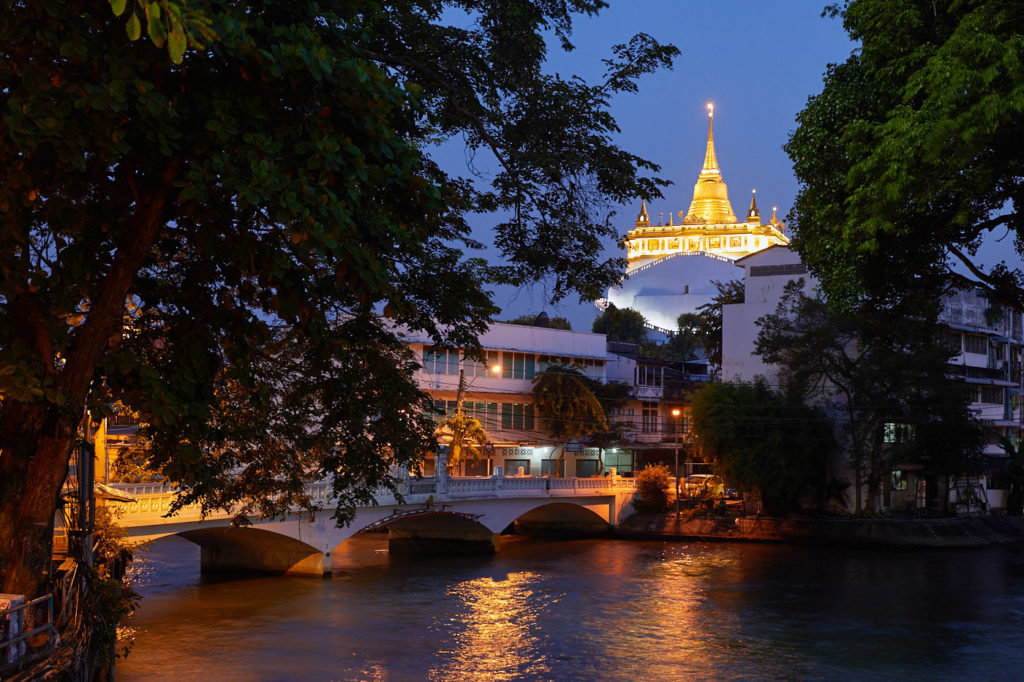
The Mahadthai Uthit Bridge or Bridge of Tears with The Golden Mount
It was Rama III who decided to build a huge chedi in the temple grounds. Unfortunately, the ground was too soft and the structure collapsed. It remained a pile of mud and bricks for several years, eventually becoming overgrown with weeds. The local inhabitants even started calling it phu khao or mountain. Rama IV ordered that the mound be reinforced and a smaller chedi built on top. A relic was brought from Sri Lanka and placed in the chedi.
In 1940 the mound was covered with concrete to protect it from erosion and, these days, the lower slopes are draped in luxuriant foliage. The chedi stands at fifty-eight metres and can be reached via about three hundred steps that wind around the mount leading to the top from where there are panoramic views of the city. It is an excellent place to watch the sun set.
Hotel suggestions
The Royal River Hotel
Tower Club at Lebua Hotel
